Prevention of Malaria among Pregnant Women in Ghana
VerifiedAdded on 2022/12/30
|10
|1536
|43
AI Summary
This document discusses the prevention of Malaria among pregnant women in Ghana. It explores the knowledge of Malaria and exhibits the risk factors linked to the disease. The document includes information on the study design, objectives, and survey instruments used.
Contribute Materials
Your contribution can guide someone’s learning journey. Share your
documents today.
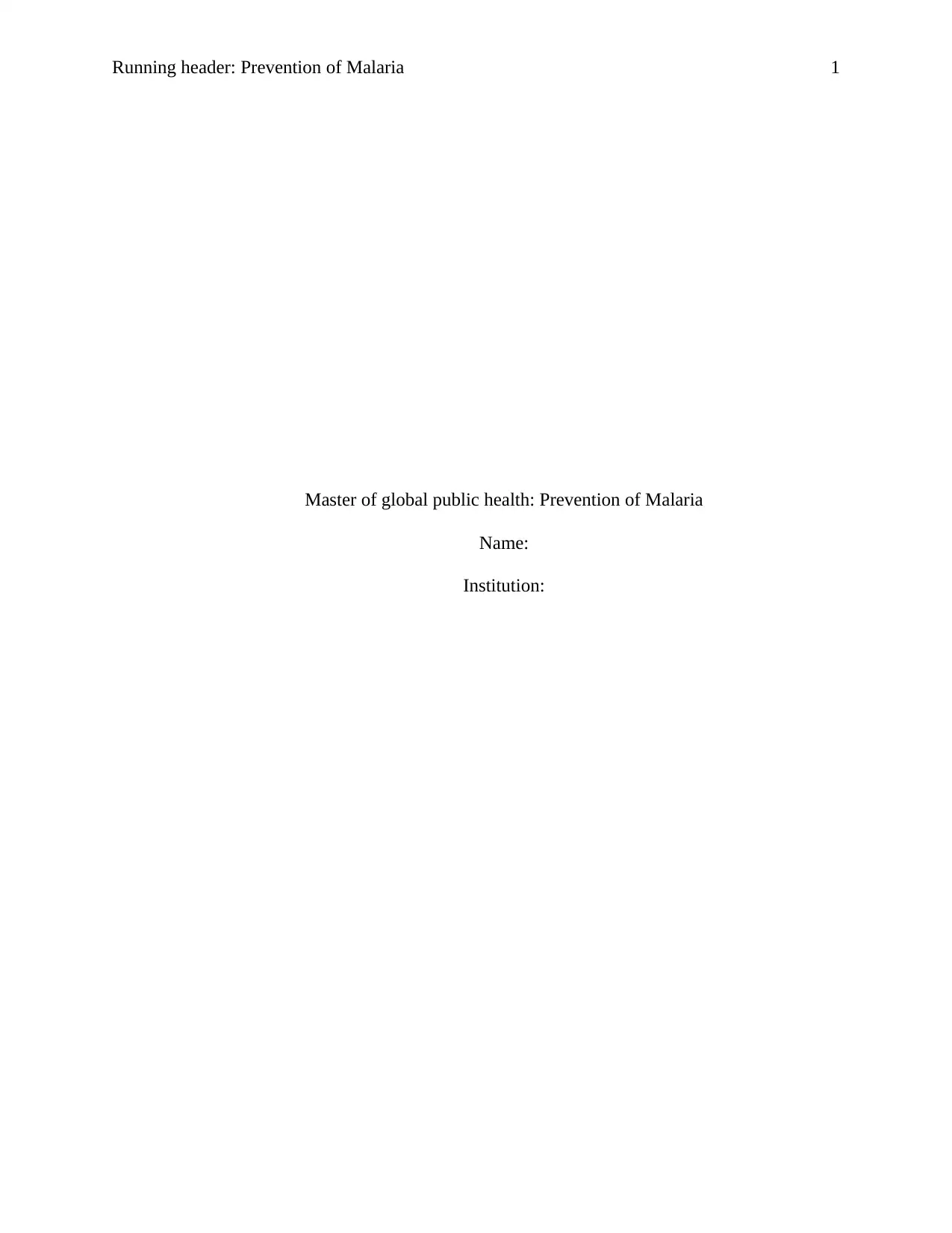
Running header: Prevention of Malaria 1
Master of global public health: Prevention of Malaria
Name:
Institution:
Master of global public health: Prevention of Malaria
Name:
Institution:
Secure Best Marks with AI Grader
Need help grading? Try our AI Grader for instant feedback on your assignments.
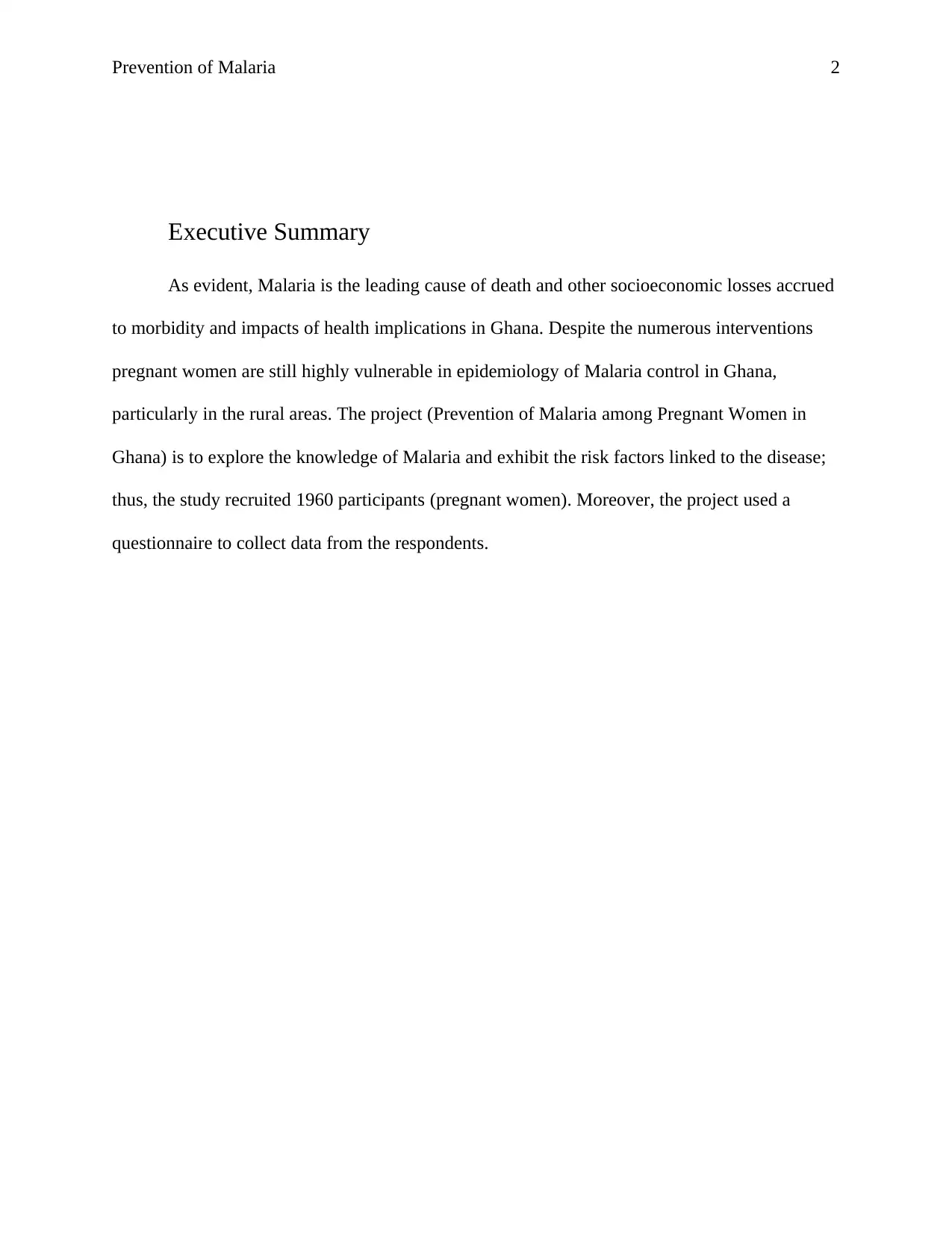
Prevention of Malaria 2
Executive Summary
As evident, Malaria is the leading cause of death and other socioeconomic losses accrued
to morbidity and impacts of health implications in Ghana. Despite the numerous interventions
pregnant women are still highly vulnerable in epidemiology of Malaria control in Ghana,
particularly in the rural areas. The project (Prevention of Malaria among Pregnant Women in
Ghana) is to explore the knowledge of Malaria and exhibit the risk factors linked to the disease;
thus, the study recruited 1960 participants (pregnant women). Moreover, the project used a
questionnaire to collect data from the respondents.
Executive Summary
As evident, Malaria is the leading cause of death and other socioeconomic losses accrued
to morbidity and impacts of health implications in Ghana. Despite the numerous interventions
pregnant women are still highly vulnerable in epidemiology of Malaria control in Ghana,
particularly in the rural areas. The project (Prevention of Malaria among Pregnant Women in
Ghana) is to explore the knowledge of Malaria and exhibit the risk factors linked to the disease;
thus, the study recruited 1960 participants (pregnant women). Moreover, the project used a
questionnaire to collect data from the respondents.
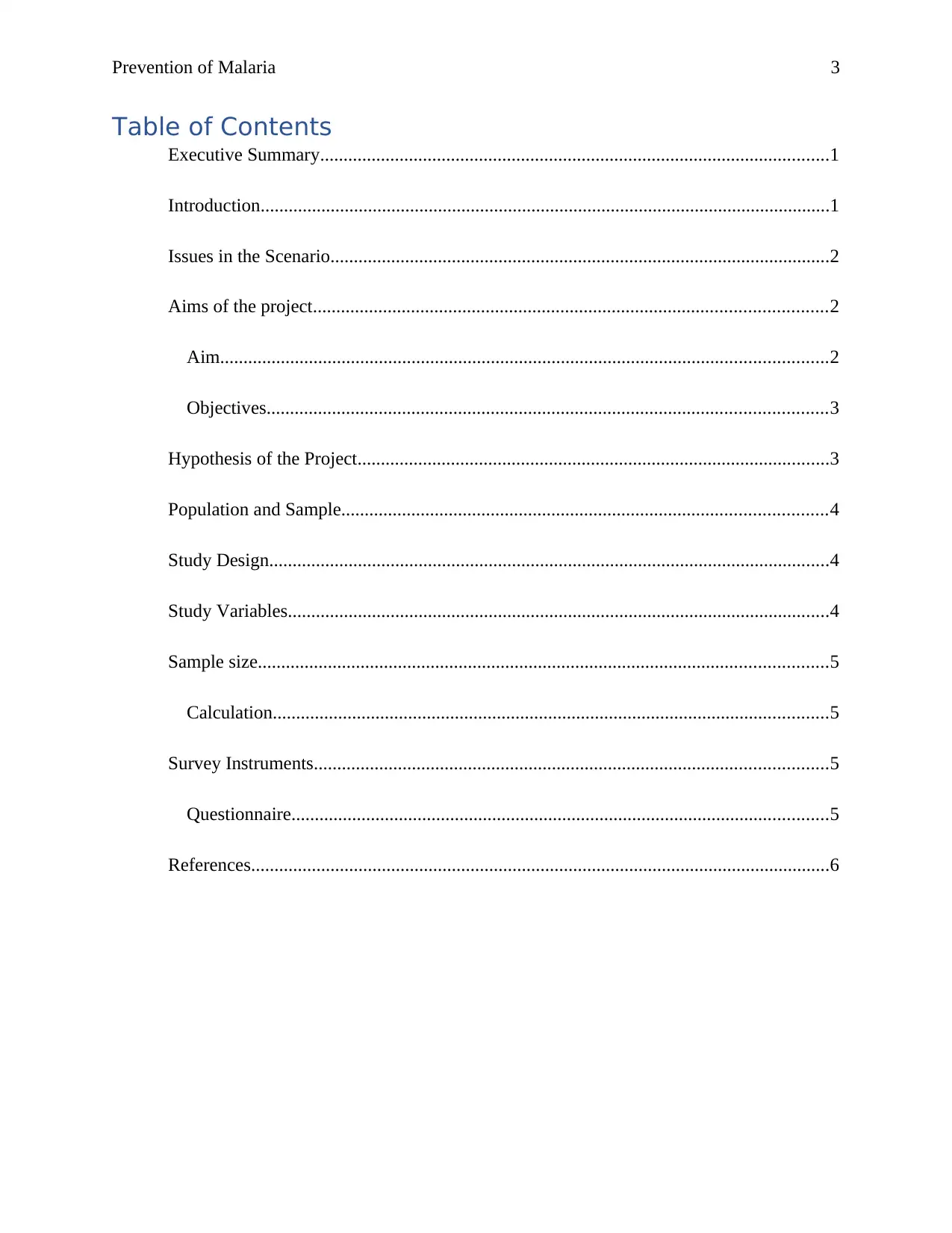
Prevention of Malaria 3
Table of Contents
Executive Summary.............................................................................................................1
Introduction..........................................................................................................................1
Issues in the Scenario...........................................................................................................2
Aims of the project..............................................................................................................2
Aim..................................................................................................................................2
Objectives........................................................................................................................3
Hypothesis of the Project.....................................................................................................3
Population and Sample........................................................................................................4
Study Design........................................................................................................................4
Study Variables....................................................................................................................4
Sample size..........................................................................................................................5
Calculation.......................................................................................................................5
Survey Instruments..............................................................................................................5
Questionnaire...................................................................................................................5
References............................................................................................................................6
Table of Contents
Executive Summary.............................................................................................................1
Introduction..........................................................................................................................1
Issues in the Scenario...........................................................................................................2
Aims of the project..............................................................................................................2
Aim..................................................................................................................................2
Objectives........................................................................................................................3
Hypothesis of the Project.....................................................................................................3
Population and Sample........................................................................................................4
Study Design........................................................................................................................4
Study Variables....................................................................................................................4
Sample size..........................................................................................................................5
Calculation.......................................................................................................................5
Survey Instruments..............................................................................................................5
Questionnaire...................................................................................................................5
References............................................................................................................................6
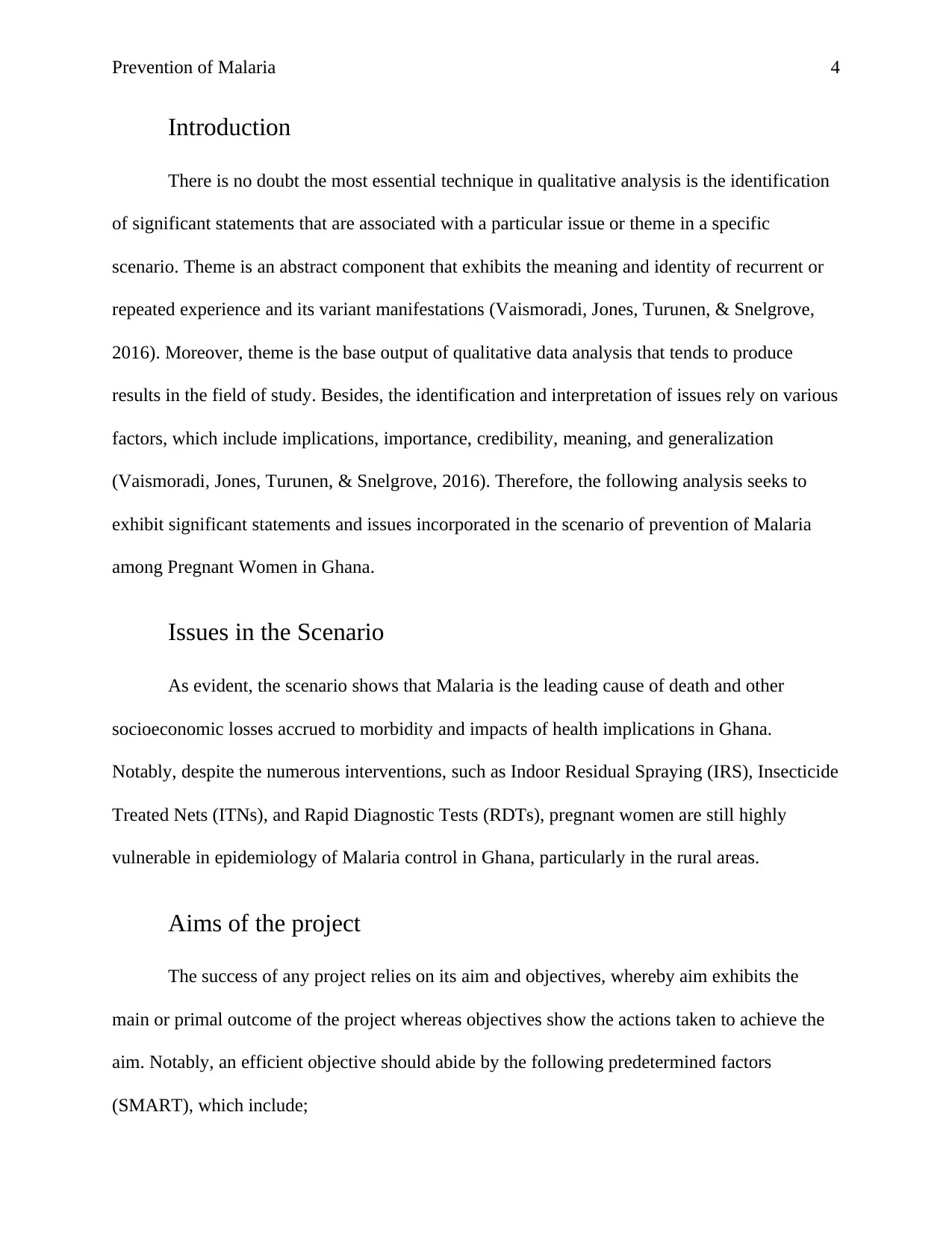
Prevention of Malaria 4
Introduction
There is no doubt the most essential technique in qualitative analysis is the identification
of significant statements that are associated with a particular issue or theme in a specific
scenario. Theme is an abstract component that exhibits the meaning and identity of recurrent or
repeated experience and its variant manifestations (Vaismoradi, Jones, Turunen, & Snelgrove,
2016). Moreover, theme is the base output of qualitative data analysis that tends to produce
results in the field of study. Besides, the identification and interpretation of issues rely on various
factors, which include implications, importance, credibility, meaning, and generalization
(Vaismoradi, Jones, Turunen, & Snelgrove, 2016). Therefore, the following analysis seeks to
exhibit significant statements and issues incorporated in the scenario of prevention of Malaria
among Pregnant Women in Ghana.
Issues in the Scenario
As evident, the scenario shows that Malaria is the leading cause of death and other
socioeconomic losses accrued to morbidity and impacts of health implications in Ghana.
Notably, despite the numerous interventions, such as Indoor Residual Spraying (IRS), Insecticide
Treated Nets (ITNs), and Rapid Diagnostic Tests (RDTs), pregnant women are still highly
vulnerable in epidemiology of Malaria control in Ghana, particularly in the rural areas.
Aims of the project
The success of any project relies on its aim and objectives, whereby aim exhibits the
main or primal outcome of the project whereas objectives show the actions taken to achieve the
aim. Notably, an efficient objective should abide by the following predetermined factors
(SMART), which include;
Introduction
There is no doubt the most essential technique in qualitative analysis is the identification
of significant statements that are associated with a particular issue or theme in a specific
scenario. Theme is an abstract component that exhibits the meaning and identity of recurrent or
repeated experience and its variant manifestations (Vaismoradi, Jones, Turunen, & Snelgrove,
2016). Moreover, theme is the base output of qualitative data analysis that tends to produce
results in the field of study. Besides, the identification and interpretation of issues rely on various
factors, which include implications, importance, credibility, meaning, and generalization
(Vaismoradi, Jones, Turunen, & Snelgrove, 2016). Therefore, the following analysis seeks to
exhibit significant statements and issues incorporated in the scenario of prevention of Malaria
among Pregnant Women in Ghana.
Issues in the Scenario
As evident, the scenario shows that Malaria is the leading cause of death and other
socioeconomic losses accrued to morbidity and impacts of health implications in Ghana.
Notably, despite the numerous interventions, such as Indoor Residual Spraying (IRS), Insecticide
Treated Nets (ITNs), and Rapid Diagnostic Tests (RDTs), pregnant women are still highly
vulnerable in epidemiology of Malaria control in Ghana, particularly in the rural areas.
Aims of the project
The success of any project relies on its aim and objectives, whereby aim exhibits the
main or primal outcome of the project whereas objectives show the actions taken to achieve the
aim. Notably, an efficient objective should abide by the following predetermined factors
(SMART), which include;
Secure Best Marks with AI Grader
Need help grading? Try our AI Grader for instant feedback on your assignments.
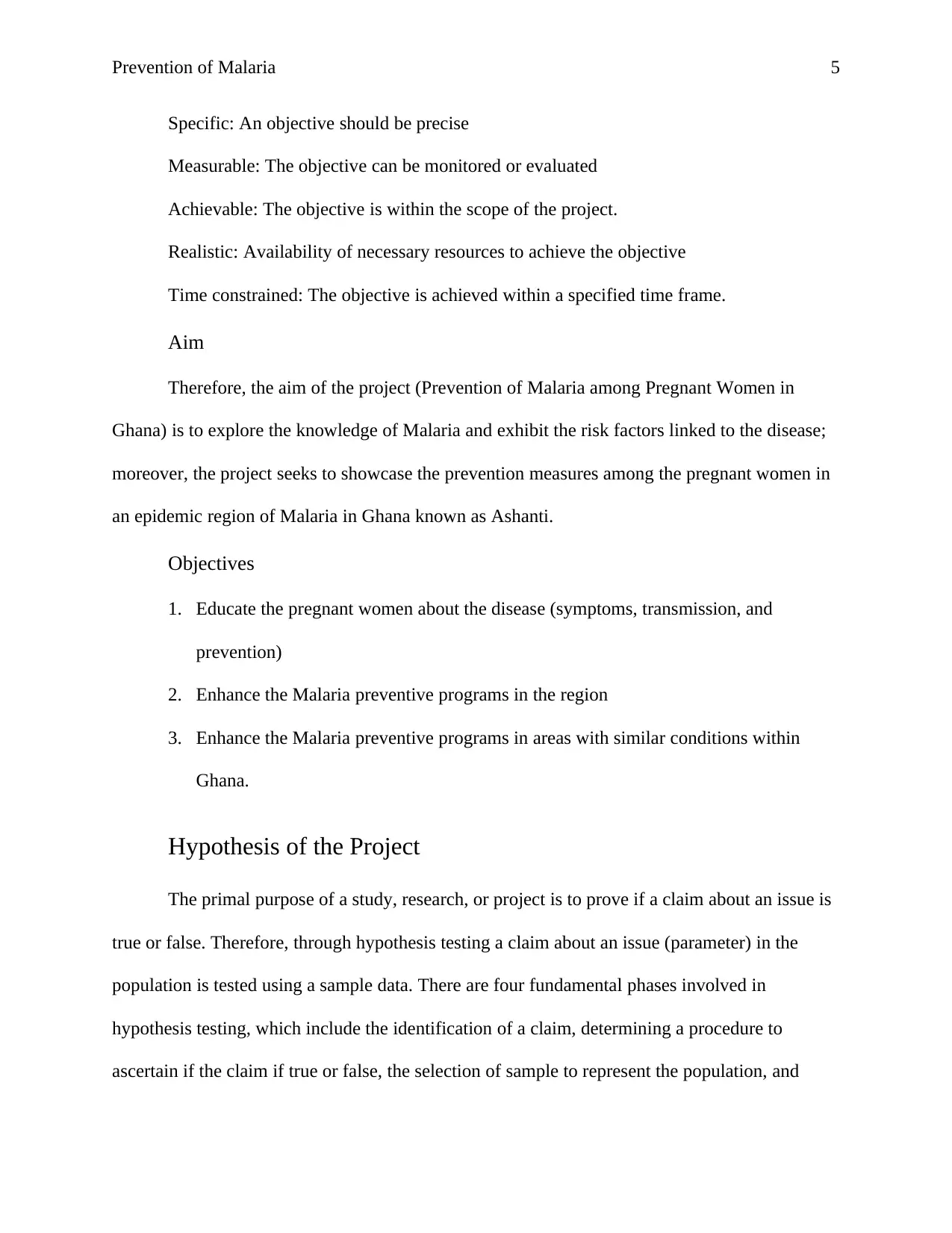
Prevention of Malaria 5
Specific: An objective should be precise
Measurable: The objective can be monitored or evaluated
Achievable: The objective is within the scope of the project.
Realistic: Availability of necessary resources to achieve the objective
Time constrained: The objective is achieved within a specified time frame.
Aim
Therefore, the aim of the project (Prevention of Malaria among Pregnant Women in
Ghana) is to explore the knowledge of Malaria and exhibit the risk factors linked to the disease;
moreover, the project seeks to showcase the prevention measures among the pregnant women in
an epidemic region of Malaria in Ghana known as Ashanti.
Objectives
1. Educate the pregnant women about the disease (symptoms, transmission, and
prevention)
2. Enhance the Malaria preventive programs in the region
3. Enhance the Malaria preventive programs in areas with similar conditions within
Ghana.
Hypothesis of the Project
The primal purpose of a study, research, or project is to prove if a claim about an issue is
true or false. Therefore, through hypothesis testing a claim about an issue (parameter) in the
population is tested using a sample data. There are four fundamental phases involved in
hypothesis testing, which include the identification of a claim, determining a procedure to
ascertain if the claim if true or false, the selection of sample to represent the population, and
Specific: An objective should be precise
Measurable: The objective can be monitored or evaluated
Achievable: The objective is within the scope of the project.
Realistic: Availability of necessary resources to achieve the objective
Time constrained: The objective is achieved within a specified time frame.
Aim
Therefore, the aim of the project (Prevention of Malaria among Pregnant Women in
Ghana) is to explore the knowledge of Malaria and exhibit the risk factors linked to the disease;
moreover, the project seeks to showcase the prevention measures among the pregnant women in
an epidemic region of Malaria in Ghana known as Ashanti.
Objectives
1. Educate the pregnant women about the disease (symptoms, transmission, and
prevention)
2. Enhance the Malaria preventive programs in the region
3. Enhance the Malaria preventive programs in areas with similar conditions within
Ghana.
Hypothesis of the Project
The primal purpose of a study, research, or project is to prove if a claim about an issue is
true or false. Therefore, through hypothesis testing a claim about an issue (parameter) in the
population is tested using a sample data. There are four fundamental phases involved in
hypothesis testing, which include the identification of a claim, determining a procedure to
ascertain if the claim if true or false, the selection of sample to represent the population, and
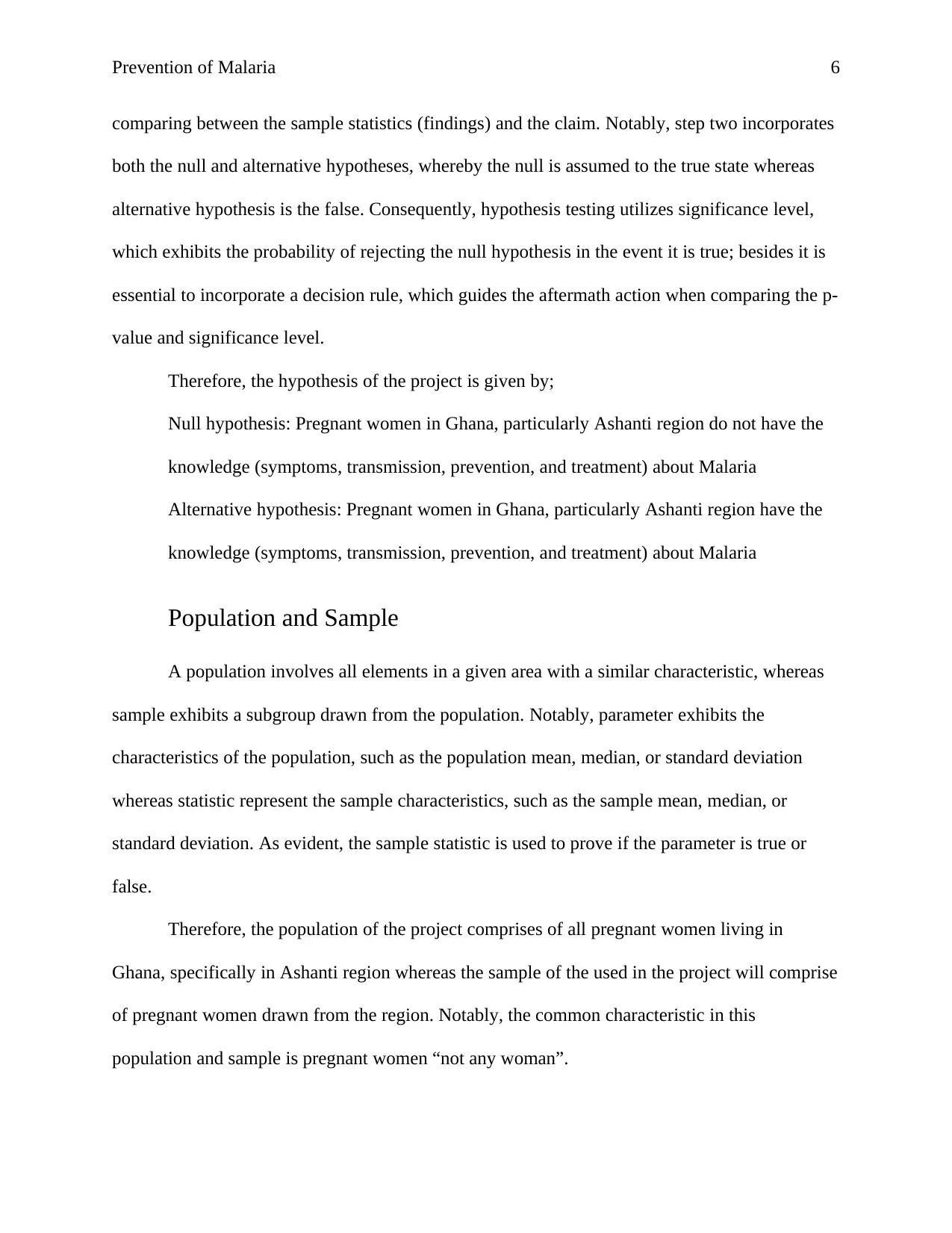
Prevention of Malaria 6
comparing between the sample statistics (findings) and the claim. Notably, step two incorporates
both the null and alternative hypotheses, whereby the null is assumed to the true state whereas
alternative hypothesis is the false. Consequently, hypothesis testing utilizes significance level,
which exhibits the probability of rejecting the null hypothesis in the event it is true; besides it is
essential to incorporate a decision rule, which guides the aftermath action when comparing the p-
value and significance level.
Therefore, the hypothesis of the project is given by;
Null hypothesis: Pregnant women in Ghana, particularly Ashanti region do not have the
knowledge (symptoms, transmission, prevention, and treatment) about Malaria
Alternative hypothesis: Pregnant women in Ghana, particularly Ashanti region have the
knowledge (symptoms, transmission, prevention, and treatment) about Malaria
Population and Sample
A population involves all elements in a given area with a similar characteristic, whereas
sample exhibits a subgroup drawn from the population. Notably, parameter exhibits the
characteristics of the population, such as the population mean, median, or standard deviation
whereas statistic represent the sample characteristics, such as the sample mean, median, or
standard deviation. As evident, the sample statistic is used to prove if the parameter is true or
false.
Therefore, the population of the project comprises of all pregnant women living in
Ghana, specifically in Ashanti region whereas the sample of the used in the project will comprise
of pregnant women drawn from the region. Notably, the common characteristic in this
population and sample is pregnant women “not any woman”.
comparing between the sample statistics (findings) and the claim. Notably, step two incorporates
both the null and alternative hypotheses, whereby the null is assumed to the true state whereas
alternative hypothesis is the false. Consequently, hypothesis testing utilizes significance level,
which exhibits the probability of rejecting the null hypothesis in the event it is true; besides it is
essential to incorporate a decision rule, which guides the aftermath action when comparing the p-
value and significance level.
Therefore, the hypothesis of the project is given by;
Null hypothesis: Pregnant women in Ghana, particularly Ashanti region do not have the
knowledge (symptoms, transmission, prevention, and treatment) about Malaria
Alternative hypothesis: Pregnant women in Ghana, particularly Ashanti region have the
knowledge (symptoms, transmission, prevention, and treatment) about Malaria
Population and Sample
A population involves all elements in a given area with a similar characteristic, whereas
sample exhibits a subgroup drawn from the population. Notably, parameter exhibits the
characteristics of the population, such as the population mean, median, or standard deviation
whereas statistic represent the sample characteristics, such as the sample mean, median, or
standard deviation. As evident, the sample statistic is used to prove if the parameter is true or
false.
Therefore, the population of the project comprises of all pregnant women living in
Ghana, specifically in Ashanti region whereas the sample of the used in the project will comprise
of pregnant women drawn from the region. Notably, the common characteristic in this
population and sample is pregnant women “not any woman”.
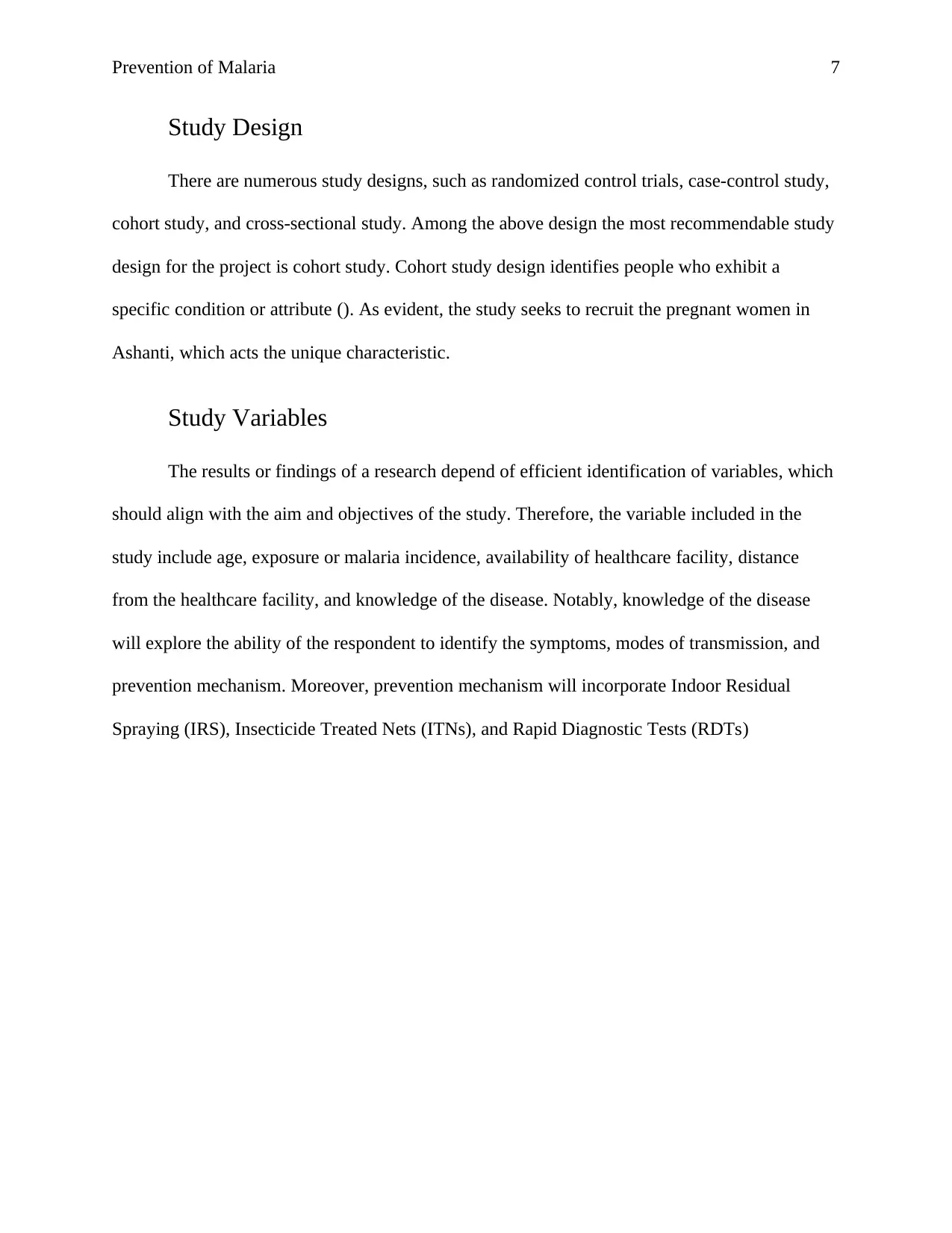
Prevention of Malaria 7
Study Design
There are numerous study designs, such as randomized control trials, case-control study,
cohort study, and cross-sectional study. Among the above design the most recommendable study
design for the project is cohort study. Cohort study design identifies people who exhibit a
specific condition or attribute (). As evident, the study seeks to recruit the pregnant women in
Ashanti, which acts the unique characteristic.
Study Variables
The results or findings of a research depend of efficient identification of variables, which
should align with the aim and objectives of the study. Therefore, the variable included in the
study include age, exposure or malaria incidence, availability of healthcare facility, distance
from the healthcare facility, and knowledge of the disease. Notably, knowledge of the disease
will explore the ability of the respondent to identify the symptoms, modes of transmission, and
prevention mechanism. Moreover, prevention mechanism will incorporate Indoor Residual
Spraying (IRS), Insecticide Treated Nets (ITNs), and Rapid Diagnostic Tests (RDTs)
Study Design
There are numerous study designs, such as randomized control trials, case-control study,
cohort study, and cross-sectional study. Among the above design the most recommendable study
design for the project is cohort study. Cohort study design identifies people who exhibit a
specific condition or attribute (). As evident, the study seeks to recruit the pregnant women in
Ashanti, which acts the unique characteristic.
Study Variables
The results or findings of a research depend of efficient identification of variables, which
should align with the aim and objectives of the study. Therefore, the variable included in the
study include age, exposure or malaria incidence, availability of healthcare facility, distance
from the healthcare facility, and knowledge of the disease. Notably, knowledge of the disease
will explore the ability of the respondent to identify the symptoms, modes of transmission, and
prevention mechanism. Moreover, prevention mechanism will incorporate Indoor Residual
Spraying (IRS), Insecticide Treated Nets (ITNs), and Rapid Diagnostic Tests (RDTs)
Paraphrase This Document
Need a fresh take? Get an instant paraphrase of this document with our AI Paraphraser
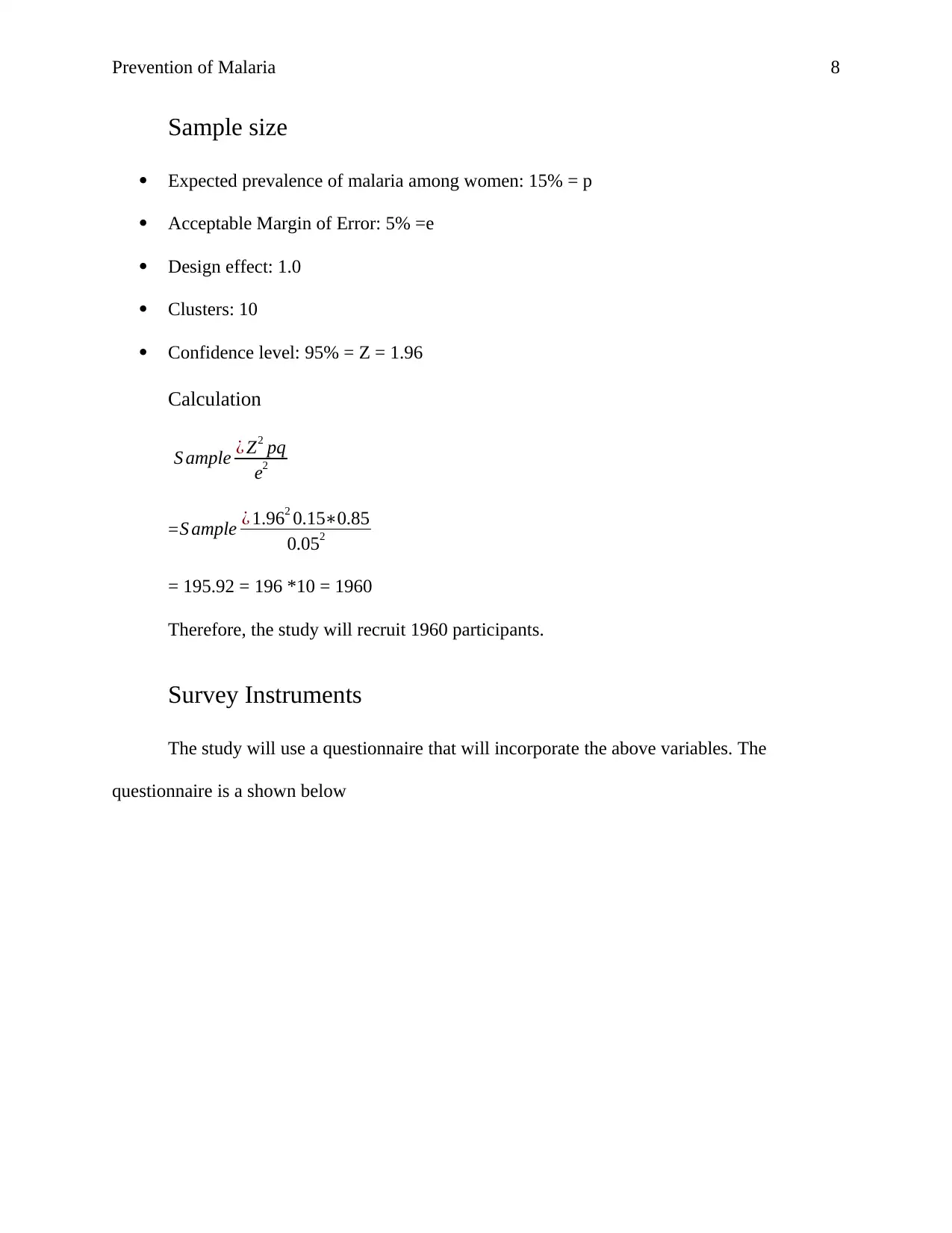
Prevention of Malaria 8
Sample size
Expected prevalence of malaria among women: 15% = p
Acceptable Margin of Error: 5% =e
Design effect: 1.0
Clusters: 10
Confidence level: 95% = Z = 1.96
Calculation
S ample ¿ Z2 pq
e2
=S ample ¿ 1.962 0.15∗0.85
0.052
= 195.92 = 196 *10 = 1960
Therefore, the study will recruit 1960 participants.
Survey Instruments
The study will use a questionnaire that will incorporate the above variables. The
questionnaire is a shown below
Sample size
Expected prevalence of malaria among women: 15% = p
Acceptable Margin of Error: 5% =e
Design effect: 1.0
Clusters: 10
Confidence level: 95% = Z = 1.96
Calculation
S ample ¿ Z2 pq
e2
=S ample ¿ 1.962 0.15∗0.85
0.052
= 195.92 = 196 *10 = 1960
Therefore, the study will recruit 1960 participants.
Survey Instruments
The study will use a questionnaire that will incorporate the above variables. The
questionnaire is a shown below
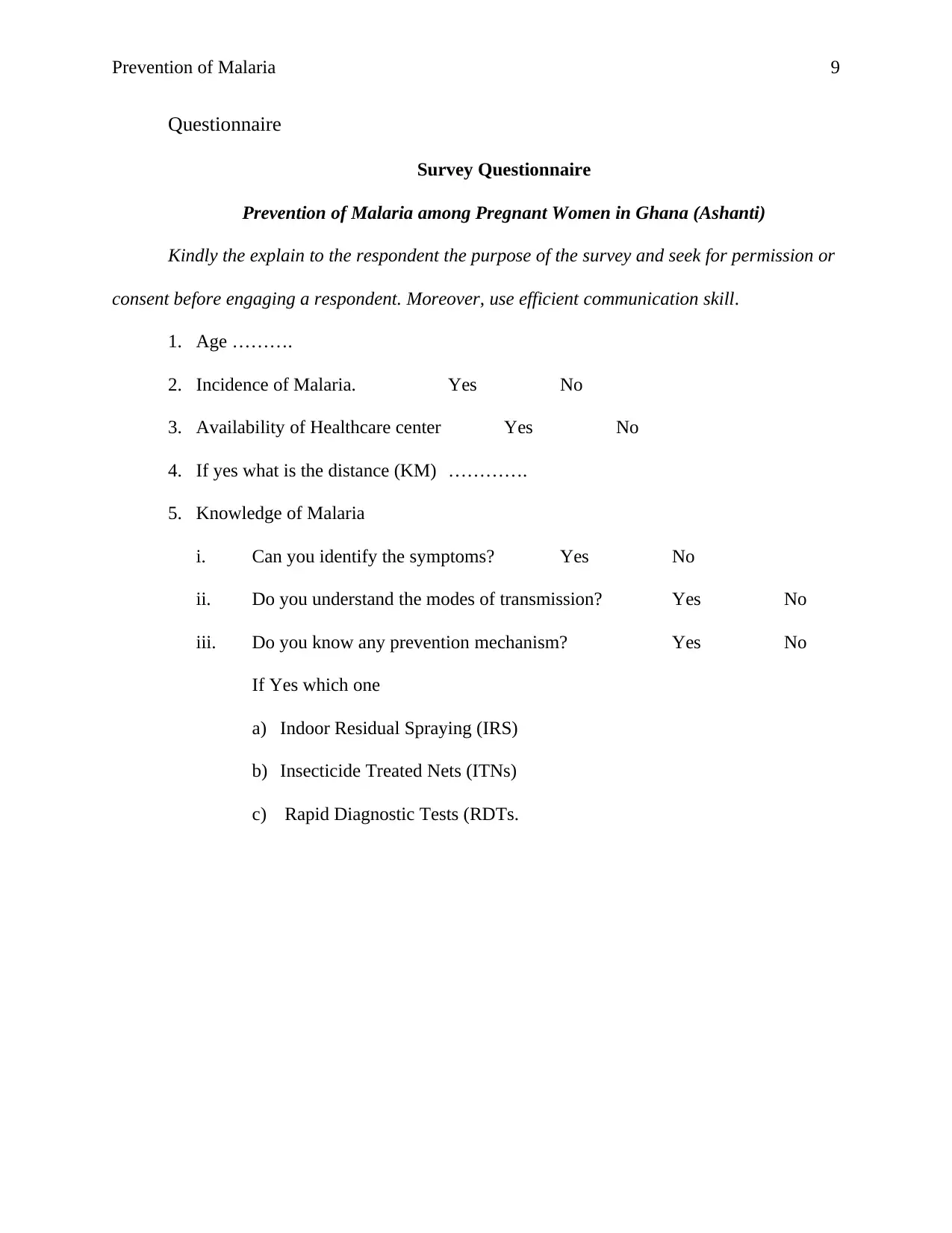
Prevention of Malaria 9
Questionnaire
Survey Questionnaire
Prevention of Malaria among Pregnant Women in Ghana (Ashanti)
Kindly the explain to the respondent the purpose of the survey and seek for permission or
consent before engaging a respondent. Moreover, use efficient communication skill.
1. Age ……….
2. Incidence of Malaria. Yes No
3. Availability of Healthcare center Yes No
4. If yes what is the distance (KM) ………….
5. Knowledge of Malaria
i. Can you identify the symptoms? Yes No
ii. Do you understand the modes of transmission? Yes No
iii. Do you know any prevention mechanism? Yes No
If Yes which one
a) Indoor Residual Spraying (IRS)
b) Insecticide Treated Nets (ITNs)
c) Rapid Diagnostic Tests (RDTs.
Questionnaire
Survey Questionnaire
Prevention of Malaria among Pregnant Women in Ghana (Ashanti)
Kindly the explain to the respondent the purpose of the survey and seek for permission or
consent before engaging a respondent. Moreover, use efficient communication skill.
1. Age ……….
2. Incidence of Malaria. Yes No
3. Availability of Healthcare center Yes No
4. If yes what is the distance (KM) ………….
5. Knowledge of Malaria
i. Can you identify the symptoms? Yes No
ii. Do you understand the modes of transmission? Yes No
iii. Do you know any prevention mechanism? Yes No
If Yes which one
a) Indoor Residual Spraying (IRS)
b) Insecticide Treated Nets (ITNs)
c) Rapid Diagnostic Tests (RDTs.

Prevention of Malaria 10
References
Vaismoradi, M., Jones, J., Turunen, H., & Snelgrove, S. (2016). Theme development in
qualitative content analysis and thematic analysis. Journal of Nursing Education and
Practice, 6(5), 100-110. doi:10.5430/jnep.v6n5p100
References
Vaismoradi, M., Jones, J., Turunen, H., & Snelgrove, S. (2016). Theme development in
qualitative content analysis and thematic analysis. Journal of Nursing Education and
Practice, 6(5), 100-110. doi:10.5430/jnep.v6n5p100
1 out of 10
Your All-in-One AI-Powered Toolkit for Academic Success.
+13062052269
info@desklib.com
Available 24*7 on WhatsApp / Email
![[object Object]](/_next/static/media/star-bottom.7253800d.svg)
Unlock your academic potential
© 2024 | Zucol Services PVT LTD | All rights reserved.

